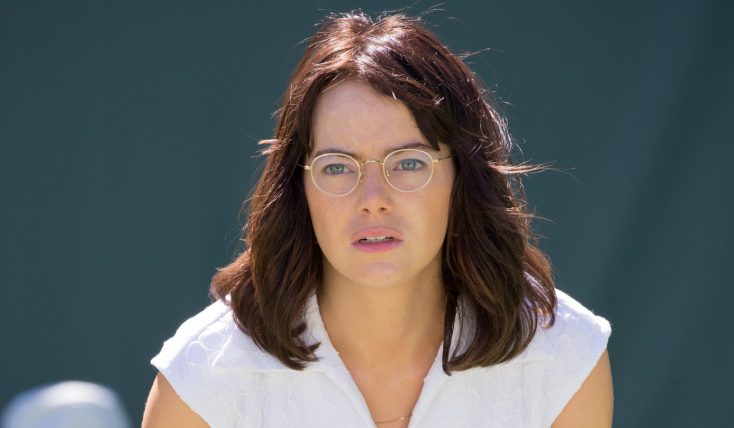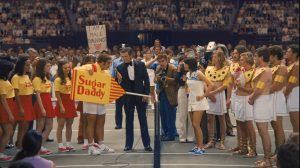By ANGELA DAWSON
Front Row Features
HOLLYWOOD—Oscar winning actress Emma Stone has played a wide range of characters in her career, from a privileged southern belle in “The Help” to a recovering drug addict in “Birdman” to an aspiring actress in her Oscar winning turn in “La La Land,” but all of them have been fictional. The actress tackles her first depiction of a real person—tennis great Billie Jean King—in the dramedy “Battle of the Sexes.”
The redheaded Arizona native admits it was initially a bit daunting to take on the role of the tennis champion who famously squared off on the court in 1973 against self-professed male chauvinist Bobby Riggs (depicted in the film by Steve Carell) in a matchup that was watched by a TV audience of nearly 90 million people around the globe. The film, directed by Valerie Faris and Jonathan Dayton (“Little Miss Sunshine”), not only delves into the very publicly hyped woman vs. man matchup, but also addresses King’s struggle with her sexual identity at that time and her push for equal pay for female tennis athletes.
At a press conference, Stone, her hair bleached blond for an upcoming TV role, spoke about portraying the tennis icon, getting into shape and hitting the court with the real Billie Jean King.
Q: It must be so exciting to take on a role like this where you have access to the person that you’re playing. On the other hand, you probably want to put a cap on the amount of time you actually spend with the person you are playing so that you don’t run into the danger of impersonating her. How did you decide what was the appropriate amount of time to spend with Billie Jean King?
Stone: I don’t think it was really a decision so much as I had never really played a real person before, much less someone like Billie Jean, so I wasn’t sure what my process was going to need to be. So, when I met her, she was so wonderful and she and her partner, Ilana (Kloss), were so welcoming to me. Billie Jean made it clear early on that she would be open to whatever process we needed to go through in order to bring this whole thing to fruition, so we threw some balls around on a tennis court and I quickly realized that I wanted to watch a lot of footage of her from the time period and read a lot about her, because she is so fully formed now and is able to talk about this with closure and hindsight. She can see it more clearly than she might have been able to at age 29. So, I ended up just doing a lot of research on her in that very specific time frame.
Q: The scene after the Battle of the Sexes match where you are back in the locker room crying is quite moving. There appears to be a couple of things going through the character’s mind at that moment. One, being that she can’t be her true self in public and, secondly, she has the burden of being held as an example for women at that time. How did you prepare to play that moment?
Stone: I was thinking about that moment in all other scenes of the film because she has such strength and because she holds it together and it’s all just right under the surface for most of the film. That sort of breaking point, you get to earn that moment of finally seeing everything that’s been happening under the surface the whole time because she was on four hours of sleep every night and all of this was going on with Marilyn (Barnett, her girlfriend) and with Larry (King, her husband). All of that, you can’t sit in the overwhelm of that and, in that moment, after winning, it was pivotal to me as an actor to know this is where we were building to.
Q: You said you wanted to do right by Billie Jean King, but you’re not a tennis pro. Was that the most difficult thing to make real for this movie? Is some of the action computer generated?
Stone: I had never played tennis. I’m not particularly good at tennis. I did a lot of lessons but I also had an incredible professional double named (former NCAA doubles champion) Kaitlyn Christian, who was phenomenal and I had an amazing coach, Vince Spadea, and a great trainer that was bulking me up so I was surrounded by great people. And I had Billie Jean throwing balls at me and letting me mirror her and figure out all the details. I was surrounded by a team of massive support when it came to that element because so much of the story is about her personal journey and personal struggle but if this had been the Billie Jean tennis movie, I never would have gotten the part. I had such an incredible team. (Filmmakers) Jonathan (Dayton) and Val (Faris) made it possible.
Q: Was learning how to play tennis the biggest hurdle and how long were you preparing before filming began?
Stone: It was a big hurdle but we were also able very early on to realize where my strengths would be and what we could use and where we could move to that would actually seem, for a novice tennis player to become number one in the world in three months. (We considered) how can we make this work with a wooden racquet? So early on we could gauge these shots would be like this or we’re going to learn the choreography of this. They can do a lot now (with CG); there’s a lot of magic out there. You’ve seem these superhero movies. So, we kind of figured out as we were going the choreography of it and that made it possible.
Q: Billie Jean King was able to bring about changes for female tennis athletes in terms of pay equality. Are you up for collaborating with Billie Jean King on pay equality for actresses?
Stone: (smiling) We can talk about it privately, and go to the media later.
Q: I heard that you put on some muscle for this part. How did that effect you and your body and performance?
Stone: It was amazing. I’d never played an athlete before and I’d never been athletic before, really. I had danced obviously (in “La La Land”) and things like that and that’s athletic but in a different way than a weightlifting tennis player. So, the beginning of the process was pretty brutal but then you get into a place that’s so amazing and you start to understand the mind of someone who is strong enough to execute whatever it is they want to execute. I want to put the ball over there, I can do it. I have the strength. I want to lift this up, I can do it.
I have these 60-pound food bags for my dogs and I was (lifting them up and saying) “I got it.” It was the most empowering feeling I thought Billie Jean is a social activist. She was always wired for social change from a young age when everyone was white, the gloves were white, the balls were white, everything, and she realized that from the very beginning but she also realized she was great at tennis and this was going to be an amazing platform for her. She could be the best to change the world.
So, physicality is everything we do with that. If you have the strength to be the best in tennis, you can change the world so that was an amazing place to get to; to understand that physical strength equals strength out in our country or in the conversation to further equality. I know that sounds a little crazy for me to say that, but I did start to put those pieces together and it was super empowering. It felt so good.
Q: Did you see the footage of pro tennis player Sloane Stephens who won the U.S. Open singles when she was recently presented with a check for $3.7 million on the court after she won? What’s it like for you to hear now that the female winner of the U.S. Open makes $3.7 million?
Stone: I was at the U.S. Open with Billie Jean King watching that moment so it was pretty unbelievable and, as Billie Jean has said, this was what she and these women in the original nine (Women’s Tennis Association) were fighting for, so how incredible it is—not to speak for (her)—but that’s what they were fighting for. They were fighting for the next generation and onward to have moments like that. I can only imagine what it feels like for Billie Jean to watch this young girl who has just won the U.S. Open get presented with $3.7 million. It’s got to be incredible.






